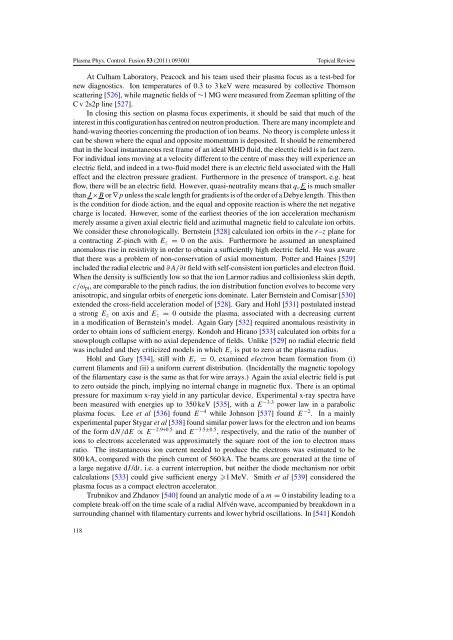You also want an ePaper? Increase the reach of your titles
YUMPU automatically turns print PDFs into web optimized ePapers that Google loves.
Plasma Phys. Control. Fusion 53 (2011) 093001<br />
Topical Review<br />
At Culham Laboratory, Peacock and his team used <strong>the</strong>ir plasma focus as a test-bed for<br />
new diagnostics. Ion temperatures <strong>of</strong> 0.3 to 3 keV were measured by collective Thomson<br />
scattering [526], while magnetic fields <strong>of</strong> ∼1 MG were measured from Zeeman splitting <strong>of</strong> <strong>the</strong><br />
C V 2s2p line [527].<br />
In closing this section on plasma focus experiments, it should be said that much <strong>of</strong> <strong>the</strong><br />
interest in this configuration has centred on neutron production. There are many incomplete and<br />
hand-waving <strong>the</strong>ories concerning <strong>the</strong> production <strong>of</strong> ion beams. No <strong>the</strong>ory is complete unless it<br />
can be shown where <strong>the</strong> equal and opposite momentum is deposited. It should be remembered<br />
that in <strong>the</strong> local instantaneous rest frame <strong>of</strong> an ideal MHD fluid, <strong>the</strong> electric field is in fact zero.<br />
For individual ions moving at a velocity different to <strong>the</strong> centre <strong>of</strong> mass <strong>the</strong>y will experience an<br />
electric field, and indeed in a two-fluid model <strong>the</strong>re is an electric field associated with <strong>the</strong> Hall<br />
effect and <strong>the</strong> electron pressure gradient. Fur<strong>the</strong>rmore in <strong>the</strong> presence <strong>of</strong> transport, e.g. heat<br />
flow, <strong>the</strong>re will be an electric field. However, quasi-neutrality means that q v E is much smaller<br />
than J ×B or ∇p unless <strong>the</strong> scale length for gradients is <strong>of</strong> <strong>the</strong> order <strong>of</strong> a Debye length. This <strong>the</strong>n<br />
is <strong>the</strong> condition for diode action, and <strong>the</strong> equal and opposite reaction is where <strong>the</strong> net negative<br />
charge is located. However, some <strong>of</strong> <strong>the</strong> earliest <strong>the</strong>ories <strong>of</strong> <strong>the</strong> ion acceleration mechanism<br />
merely assume a given axial electric field and azimuthal magnetic field to calculate ion orbits.<br />
We consider <strong>the</strong>se chronologically. Bernstein [528] calculated ion orbits in <strong>the</strong> r–z plane for<br />
a contracting Z-<strong>pinch</strong> with E z = 0 on <strong>the</strong> axis. Fur<strong>the</strong>rmore he assumed an unexplained<br />
anomalous rise in resistivity in order to obtain a sufficiently high electric field. He was aware<br />
that <strong>the</strong>re was a problem <strong>of</strong> non-conservation <strong>of</strong> axial momentum. Potter and Haines [529]<br />
included <strong>the</strong> radial electric and ∂A/∂t field with self-consistent ion particles and electron fluid.<br />
When <strong>the</strong> density is sufficiently low so that <strong>the</strong> ion Larmor radius and collisionless skin depth,<br />
c/ω pi , are comparable to <strong>the</strong> <strong>pinch</strong> radius, <strong>the</strong> ion distribution function evolves to become very<br />
anisotropic, and singular orbits <strong>of</strong> energetic ions dominate. Later Bernstein and Comisar [530]<br />
extended <strong>the</strong> cross-field acceleration model <strong>of</strong> [528]. Gary and Hohl [531] postulated instead<br />
a strong E z on axis and E z = 0 outside <strong>the</strong> plasma, associated with a decreasing current<br />
in a modification <strong>of</strong> Bernstein’s model. Again Gary [532] required anomalous resistivity in<br />
order to obtain ions <strong>of</strong> sufficient energy. Kondoh and Hirano [533] calculated ion orbits for a<br />
snowplough collapse with no axial dependence <strong>of</strong> fields. Unlike [529] no radial electric field<br />
was included and <strong>the</strong>y criticized models in which E z is put to zero at <strong>the</strong> plasma radius.<br />
Hohl and Gary [534], still with E r = 0, examined electron beam formation from (i)<br />
current filaments and (ii) a uniform current distribution. (Incidentally <strong>the</strong> magnetic topology<br />
<strong>of</strong> <strong>the</strong> filamentary case is <strong>the</strong> same as that for wire arrays.) Again <strong>the</strong> axial electric field is put<br />
to zero outside <strong>the</strong> <strong>pinch</strong>, implying no internal change in magnetic flux. There is an optimal<br />
pressure for maximum x-ray yield in any particular device. Experimental x-ray spectra have<br />
been measured with energies up to 350 keV [535], with a E −3.3 power law in a parabolic<br />
plasma focus. Lee et al [536] found E −4 while Johnson [537] found E −2 . In a mainly<br />
experimental paper Stygar et al [538] found similar power laws for <strong>the</strong> electron and ion beams<br />
<strong>of</strong> <strong>the</strong> form dN/dE ∝ E −2.9+0.5 and E −3.5±0.5 , respectively, and <strong>the</strong> ratio <strong>of</strong> <strong>the</strong> number <strong>of</strong><br />
ions to electrons accelerated was approximately <strong>the</strong> square root <strong>of</strong> <strong>the</strong> ion to electron mass<br />
ratio. The instantaneous ion current needed to produce <strong>the</strong> electrons was estimated to be<br />
800 kA, compared with <strong>the</strong> <strong>pinch</strong> current <strong>of</strong> 560 kA. The beams are generated at <strong>the</strong> time <strong>of</strong><br />
a large negative dI/dt, i.e. a current interruption, but nei<strong>the</strong>r <strong>the</strong> diode mechanism nor orbit<br />
calculations [533] could give sufficient energy 1 MeV. Smith et al [539] considered <strong>the</strong><br />
plasma focus as a compact electron accelerator.<br />
Trubnikov and Zhdanov [540] found an analytic mode <strong>of</strong> a m = 0 instability leading to a<br />
complete break-<strong>of</strong>f on <strong>the</strong> time scale <strong>of</strong> a radial Alfvén wave, accompanied by breakdown in a<br />
surrounding channel with filamentary currents and lower hybrid oscillations. In [541] Kondoh<br />
118














